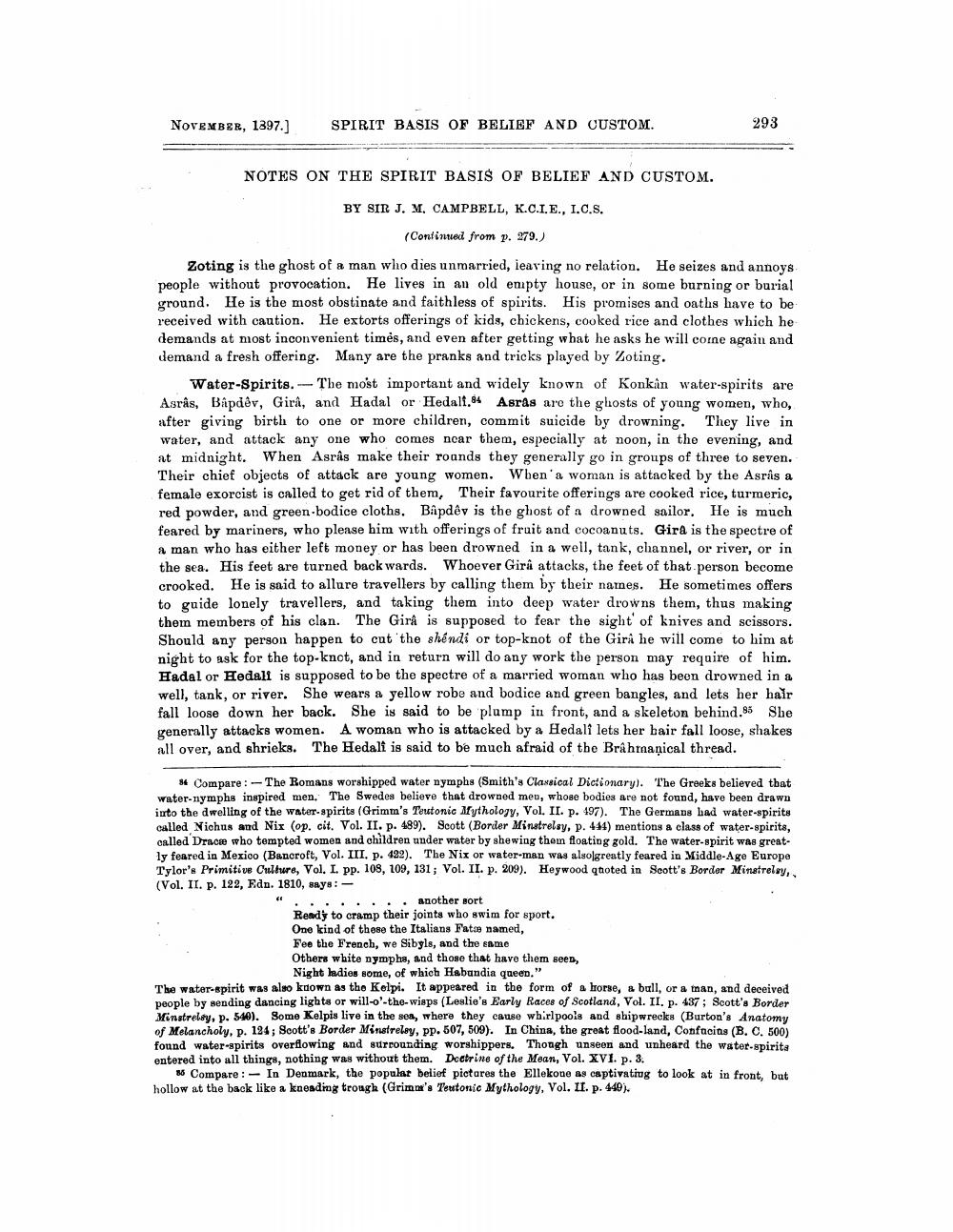________________
November, 1397.]
SPIRIT BASIS OF BELIEF AND CUSTOM
293
NOTES ON THE SPIRIT BASIS OF BELIEF AND CUSTOM.
BY SIR J. M. CAMPBELL, K.C.I.E., I.C.S.
(Continued from p. 279.)
Zoting is the ghost of a man who dies unmarried, leaving no relation. He seizes and annoys people without provocation. He lives in an old empty house, or in some burning or burial ground. He is the most obstinate and faithless of spirits. His promises and oaths have to be received with caution. He extorts offerings of kids, chickens, cooked rice and clothes which he demands at most inconvenient times, and even after getting what he asks he will come again and demand a fresh offering. Many are the pranks and tricks played by Zoting.
Water-Spirits. The most important and widely known of Konkan water-spirits are Asrâs, Bapdêv, Gira, and Hadal or Hedali.84 Asras are the ghosts of young women, who, after giving birth to one or more children, commit suicide by drowning. They live in water, and attack any one who comes near them, especially at noon, in the evening, and at midnight. When Asrâs make their rounds they generally go in groups of three to seven. Their chief objects of attack are young women. When a woman is attacked by the Asras a female exorcist is called to get rid of them. Their favourite offerings are cooked rice, turmeric, red powder, and green-bodice cloths. Bapdêr is the ghost of a drowned sailor. He is much feared by mariners, who please him with offerings of fruit and cocoanuts. Gira is the spectre of a man who has either left money or has been drowned in a well, tank, channel, or river, or in the sea. His feet are turned backwards. Whoever Girâ attacks, the feet of that person become crooked. He is said to allure travellers by calling them by their names. He sometimes offers to guide lonely travellers, and taking them into deep water drowns them, thus making them members of his clan. The Girà is supposed to fear the sight' of knives and scissors. Should any person happen to cut the shendi or top-knot of the Girà he will come to him at night to ask for the top-knot, and in return will do any work the person may require of him. Hadal or Hedalt is supposed to be the spectre of a married woman who has been drowned in a well, tank, or river. She wears a yellow robe and bodice and green bangles, and lets her hair fall loose down her back. She is said to be plump in front, and a skeleton behind.85 She generally attacks women. A woman who is attacked by a Hedali lets her hair fall loose, shakes all over, and shrieks. The Hedali is said to be much afraid of the Brahmaņical thread.
84 Compare: The Romans worshipped water nymphs (Smith's Classical Dictionary). The Greeks believed that water-nymphs inspired men. The Swedes believe that drowned meu, whose bodies are not found, have been drawn into the dwelling of the water-spirits (Grimm's Teutonic Mythology, Vol. II. p. 497). The Germans had water-spirits called Nichus and Nix (op. cit. Vol. II. p. 489). Scott (Border Minstrelsy, p. 411) mentions a class of water-spirits, called Dracæ who tempted women and children under water by shewing them floating gold. The water-spirit was greatly feared in Mexico (Bancroft, Vol. III. p. 422). The Nix or water-man was also greatly feared in Middle-Age Europe Tylor's Primitive Culture, Vol. I. pp. 108, 109, 131 ; Vol. II. p. 209). Heywood quoted in Scott's Border Minstrelsy, (Vol. II. p. 122, Edn. 1810, says:
. . . . . . . . another sort Ready to cramp their joints who swim for sport. One kind of these the Italians Fate named, Fee the French, we Sibyls, and the same Others white nymphs, and those that have them seen,
Night ladies some, of which Habandia queen." The water-spirit was also known as the Kelpi. It appeared in the form of a horse, a ball, or a man, and deceived people by sending dancing lights or will-o'-the-wisps (Leslie's Early Races of Scotland, Vol. II. p. 437 ; Scott's Border Minstrelsy, p. 540). Some Kelpis live in the sea, where they cause whirlpools and shipwrecks (Burton's Anatomy of Melancholy, p. 124; Scott's Border Minstreløy, pp. 507, 509). In China, the great flood-land, Confucins (B. C. 500) found water-spirits overflowing and surrounding worshippers. Though unseen and unheard the water-spirita entered into all things, nothing was without them. Doctrine of the Mean, Vol. XVI. p. 3.
Compare : - In Denmark, the popular belief pictures the Ellekone as captivating to look at in front, but hollow at the back like a kneading trough (Grimm's Teutonic Mythology, Vol. II. p. 440).




